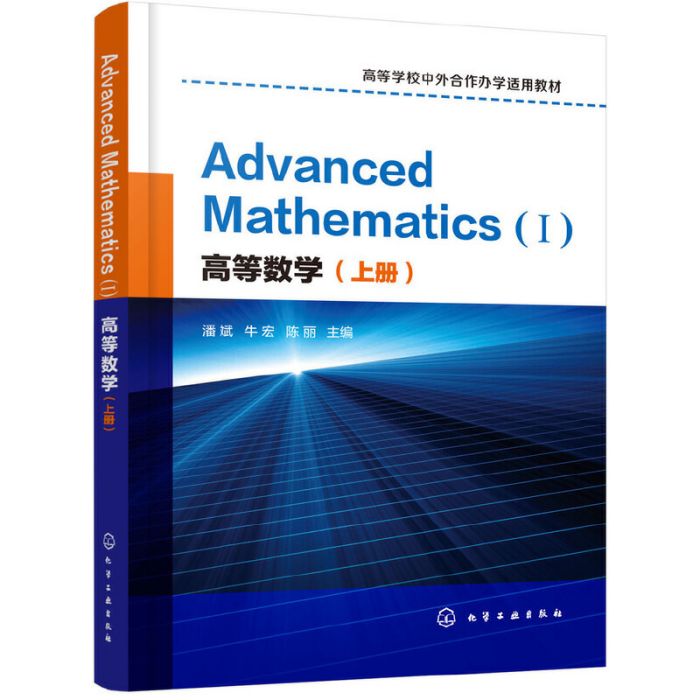基本介紹
- 中文名:高等數學(上冊)Advanced Mathematics (Ⅰ):英文
- 作者:潘斌,牛宏,陳麗
- 出版時間:2019年09月
- 出版社:化學工業出版社
- ISBN:9787122346971
- 類別:高等數學
- 定價:¥78.00
- 開本:16 開
- 裝幀:平裝
內容簡介,目錄,
內容簡介
本書是根據教育部非數學專業數學基礎課教學指導分委員會制定的工科類本科數學基礎課程教學基本要求編寫的全英文教材,全書分為上、下兩冊。本書為上冊,主要包括函式與極限,一元函式微積分及其套用和微分方程三部分。本書對基本概念的敘述清晰準確,對基本理論的論述簡明易懂,例題習題的選配典型多樣,強調基本運算能力的培養及理論的實際套用。本書可作為高等理工科院校非數學類專業本科生的教材,也可供其他專業選用和社會讀者閱讀。
The aim of this book is to meet the requirement of bilingual teaching ofadvanced mathematics. The selection of the contents is in accordance with thefundamental requirements of teaching issued by the Ministry of Education ofChina.
Base on the property of our university,we select someexamples about petrochemical industry. These examples may help readers tounderstand the application of advanced mathematics in petrochemical industry.
This book is divided into two volumes. This volume contains functions andlimits, calculus of functions of a single variable and differential equation.Basic concepts in this book are clear and accurate. The book introduce thefundamental theories by a method that is easy for understanding.
This book can be used as a textbook for undergraduate students in the science andengineering schools whose majors are not mathematics, and may also be suitableto the readers at the same level.
目錄
Chapter 1 Functions and limits1
1.1Mappings and functions1
1.1.1Sets1
1.1.2Mappings4
1.1.3Functions5
Exercises 1-1 19
1.2Limits of sequences23
1.2.1Concept of limits of sequences23
1.2.2Properties of convergent sequences27
Exercises 1-2 29
1.3Limits of functions30
1.3.1Definitions of limits of functions30
1.3.2The properties of functional limits33
Exercises 1-3 34
1.4Infinitesimal and infinity quantity36
1.4.1Infinitesimal quantity36
1.4.2Infinity quantity36
Exercises 1-4 38
1.5Rules of limit operations38
Exercises 1-5 43
1.6Principle of limit existence—twoimportant limits44
Exercises 1-6 49
1.7Comparing with two infinitesimals50
Exercises 1-7 52
1.8Continuity of functions and discontinuous points52
1.8.1Continuity of functions52
1.8.2Discontinuous points of functions54
Exercises 1-8 56
1.9Operations on continuous functions and the continuity of elementary functions57
1.9.1Continuity of the sum,difference,product and quotient of continuous functions57
1.9.2Continuity of inverse functions and composite functions58
1.9.3Continuity of elementary functions59
Exercises 1-9 59
1.10Properties of continuous functions on a closed interval60
1.10.1Boundedness and maximum-minimum theorem60
1.10.2Zero point theorem and intermediate value theorem61
*1.10.3Uniform continuity62
Exercises 1-10 63
Exercises 1 63
Chapter 2 Derivatives and differential66
2.1Concept of derivatives66
2.1.1Examples66
2.1.2Definition of derivatives70
2.1.3Geometric interpretation of derivative77
2.1.4Relationship between derivability and continuity78
Exercises 2-1 79
2.2Fundamental derivation rules81
2.2.1Derivation rules for sum,difference,product and quotient of functions81
2.2.2The rules of derivative of inverse functions83
2.2.3The rules of derivative of composite functions(TheChain Rule)85
2.2.4Basic derivation rules and derivative formulas89
Exercises 2-2 91
2.3Higher-order derivatives93
Exercises 2-3 95
2.4Derivation of implicit functions and functions defined by parametricequations97
2.4.1Derivation of implicit functions97
2.4.2Derivation of a function defined by parametric equations101
2.4.3Related rates of change103
Exercises 2-4 103
2.5The Differentials of functions105
2.5.1Concept of the differential105
2.5.2Geometric meaning of the differential107
2.5.3Formulas and rules on differentials108
2.5.4Application of the differential in approximate computation109
Exercises 2-5 110
Exercises 2 111
Chapter 3 Mean value theorems in differential calculus and applications ofderivatives113
3.1Mean value theorems in differential calculus113
Exercises 3-1 120
3.2L’Hospital’s rules121
Exercises 3-2 125
3.3Taylor formula126
Exercises 3-3 130
3.4Monotonicity of functions and convexity of curves131
3.4.1Monotonicity of functions131
3.4.2Convexity of curves and inflection points132
Exercises 3-4 136
3.5Extreme values of functions, maximum and minimum137
3.5.1Extreme values of functions137
3.5.2Maximum and minimum of function140
Exercises 3-5 143
3.6Differentiation of arc and curvature145
3.6.1Differentiation of an arc145
3.6.2curvature146
Exercises 3-6 149
Exercises 3 149
Chapter 4 Indefinite integral151
4.1Concept and property of indefinite integral151
4.1.1Concept of antiderivative and indefinite integral151
4.1.2Table of fundamental indefinite integrals153
4.1.3Properties of the indefinite integral155
Exercises 4-1 157
4.2Integration by substitutions158
4.2.1Integration by substitution of the first kind158
4.2.2Integration by substitution of the second kind163
Exercises 4-2 167
4.3Integration by parts169
Exercises 4-3 173
4.4Integration of rational function173
4.4.1Integration of rational function173
4.4.2Integration which can be transformed into the integration of rationalfunction175
Exercises 4-4 177
Exercises 4 178
Chapter 5 Definite integrals180
5.1Concept and properties of definite integrals180
5.1.1Examples of definite integral problems180
5.1.2The definition of define integral182
5.1.3Properties of definite integrals184
Exercises 5-1 186
5.2Fundamental formula of calculus188
5.2.1The relationship between the displacement and the velocity188
5.2.2A function of upper limit of integral188
5.2.3Newton-Leibniz formula189
Exercises 5-2 192
5.3Integration by substitution and parts for definite integrals194
5.3.1Integration by substitution for definite integrals194
5.3.2Integration by parts for definite integral198
Exercises 5-3 199
5.4Improper integrals201
5.4.1Improper integrals on an infinite interval201
5.4.2Improper integrals of unbounded functions203
Exercises 5-4 205
5.5Tests for convergence of improper integralsΓ-function206
5.5.1Test for convergence of infinite integral206
5.5.2Test for convergence of improper integrals of unbounded functions209
5.5.3 Γ-function209
Exercises 5-5 211
Exercises 5 212
Chapter 6 Applications of definite integrals214
6.1Method of elements for definite integrals214
6.2The applications of the definite integral in geometry215
6.2.1Areas of plane figures215
6.2.2The volumes of solid219
6.2.3Length of plane curves222
Exercises 6-2 224
6.3The applications of the definite Integral in physics227
6.3.1Work done by variable force227
6.3.2Force by a liquid228
6.3.3Gravity229
Exercises 6-3 230
Exercises 6 230
Chapter 7 Differential equations232
7.1Differential equations and their solutions232
Exercises 7-1 236
7.2Separable equations237
Exercises 7-2 240
7.3Homogeneous equations241
7.3.1Homogeneous equations241
7.3.2Reduction to homogeneous equation243
Exercises 7-3 245
7.4A first-order linear differential equations245
7.4.1Linear equations245
7.4.2Bernoulli’s equation248
Exercises 7-4 249
7.5Reducible second-order equations250
Exercises 7-5 254
7.6Second-order linear equations254
7.6.1Construction of solutions of second-order linear equation254
7.6.2The method of variation of parameters257
Exercises 7-6 259
7.7Homogeneous linear differential equation with constant coefficients259
Exercises 7-7 263
7.8Nonhomogeneous linear differential equation with constant coefficients264
Exercises 7-8 270
7.9Euler’s differential equation270
Exercises 7-9 271
Exercises 7 271
Appendix273
References280

